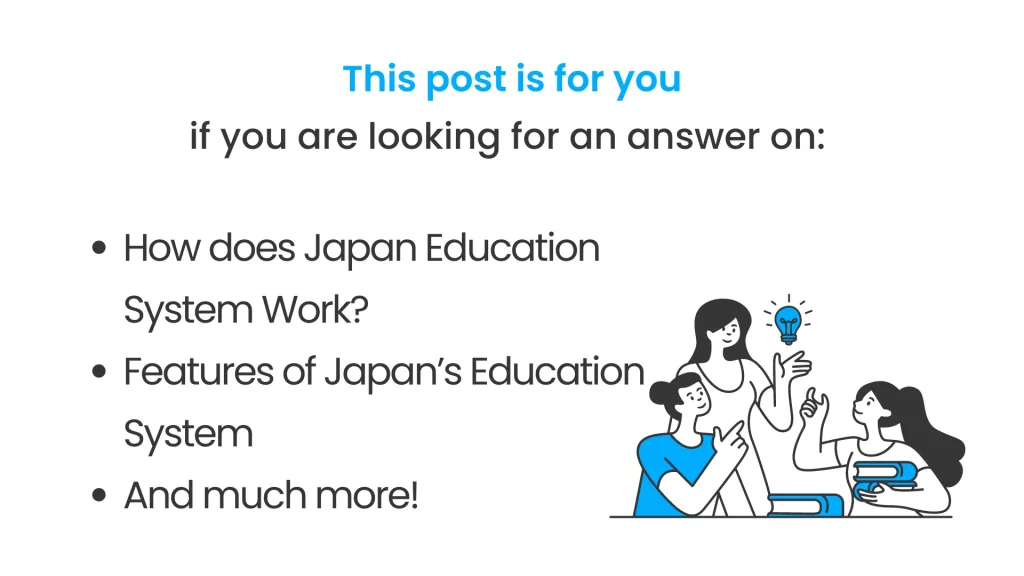The Japan Education System is known for its excellence. The country is renowned for its high academic attainment levels, exacting standards, and strong focus on respect and discipline. The Japan education system is set up to help pupils succeed academically and professionally. Students are instilled with the value of perseverance, hard work, and self-discipline from an early age because these traits are highly regarded in Japanese culture. Japan’s education system is a step ahead of its competitors and keeps updating the curriculum according to the latest changes.
The academic rigor of the Japan educational system is well-known, and students are expected to excel in disciplines like math, science, and technology. Several studies and research have been conducted on the Japan educational system in an effort to determine why it is so successful. In this blog post, we will examine the peculiarities of the Japanese educational system in greater detail, its advantages and disadvantages, and how it affects Japanese society and culture. We will also look at how the Japan education system has changed over time and how it is still evolving to meet the demands of students in the twenty-first century.
Topics covered
What all is covered in this post?
In this blog post, we shall learn about the Japan education system and why it is one of the best in business in the contemporary world.

How does Japan education system work?
Academic quality and discipline are highly valued in the well-established and strict Japan education system. Here are some crucial details that clarify how the system functions:
- Mandatory Education: Education in Japan is mandated for all children between the ages of 6 and 15, and the majority of pupils attend both junior high school (3 years) and elementary school (6 years).
- High School Education: After finishing junior high school, students have the option of attending an academic, vocational, or specialized high school.
- Academic High Schools: Academic high schools place a strong emphasis on preparing pupils for the notoriously difficult and competitive university entrance tests in Japan. Academic disciplines including math, physics, and language are highly valued in these schools.
- Vocational high schools: Vocational schools provide instruction in professions like agriculture, engineering, and nursing. These institutions place a strong emphasis on imparting practical knowledge and abilities to prepare students for careers in particular industries.
- Specialty High Schools: Specialist high schools are created to teach and train students in certain subjects like music, the arts, or sports. These institutions cater to pupils who have a particular aptitude for or interest in a given field.
- Education at a university: After high school, students have the option to enroll in a university, which normally lasts four years. University admission is extremely tough and is determined by entrance examinations, academic standing, and extracurricular involvement.
- Education Culture: The Japanese educational system places a high value on hard effort, respect, and discipline. Teachers are highly recognized authority figures in the classroom, and students are expected to be serious and engaged in their studies.
Features of Japan’s Education System
The education system in Japan is renowned for having distinctive elements that have helped it be successful in turning out pupils who perform well academically. Following are some of the main characteristics of the educational system in Japan:
- Emphasis on discipline: Japan educational system lays a great focus on respect and discipline, and pupils are expected to act in an appropriate and orderly manner at all times.
- Rigorous standards: High Academic Standards and a Strict Approach to Learning: The Japanese educational system is renowned for its high academic standards and rigorous approach to learning, notably in disciplines like math, science, and language.
- Extended School Days: Compared to other nations, school days in Japan are often longer. Students frequently attend lessons from the early morning until the late afternoon or evening.
- Extra-curricular activities: Students in Japan frequently participate in a range of extracurricular activities, such as sports teams or music ensembles, which aid in the development of their interests and talents outside of the classroom.
- Entrance Exams: For admittance to high schools and universities, entrance tests are extremely important in Japan’s educational system. Students spend a lot of time studying and preparing for these exams since they are so difficult and competitive.
- Teacher Certification: Before being allowed to teach in a school, teachers must complete extensive training and certification programs. Teachers in Japan are well-respected, highly qualified professionals.
- Emphasis on Group Learning: Students frequently collaborate with one another on projects and assignments in Japan’s educational system, which places a significant focus on group learning and teamwork.
- Moral Education: Moral education is a crucial component of Japan’s educational system, with a focus on helping students improve both their moral character and their intellectual abilities.
Grading System in Japan
The Japanese educational system’s grading system is an essential component that determines a student’s academic performance and future chances. Below is a summary of the Japanese grading system:
| Scoring Systems | Japanese students are graded on a scale of 0 to 100, with 60 being regarded as a passing grade. The grading system, however, might change based on the subject and the school. |
| Grading Criteria | In Japan, grades are often assigned according to a variety of criteria, such as class participation, homework assignments, tests, and general academic success. |
| Different Types of Exams | The educational system in Japan uses a variety of exams, including quick quizzes, midterm exams, and final exams. Each exam’s weighting can change depending on the subject and the institution. |
| Use of Rankings | Rankings are frequently utilized in Japan’s educational system in addition to grades. Based on academic performance, these rankings are used to decide future changes, such as the entrance to high schools and universities. |
| Subject-specific Grading | Grades can differ greatly depending on the subject, with some disciplines like math and science being especially competitive and difficult. A good mark in these areas can mean a lot and be essential for future academic possibilities. |
Key Stages in Japan Education System
As students grow in their academic careers, they move through a number of critical stages that make up the Japanese educational system. The major phases of Japan’s educational system are as follows:
- Preschool: From the time they are three until they are ready to start primary school, Japanese kids can attend preschool.
- Primary School: In Japan, all students between the ages of six and twelve must attend primary school, which normally lasts six years. The emphasis is on fundamental academic abilities including reading, writing, and math.
- Lower Secondary School: From the time a pupil completes primary school until the age of fifteen, they attend lower secondary school for three years. The emphasis is on strengthening the base of fundamental academic abilities and extending to new subjects including science, social studies, and physical education.
- Upper Secondary School: During the ages of fifteen to eighteen, the majority of students in Japan attend upper secondary school, which is not required. Upper secondary schools come in two varieties: academic institutions that educate students for further education and vocational schools that offer training for certain occupations.
- University: After completing upper secondary school, students can attend a university or junior college, which typically lasts for four years. Entrance exams for universities in Japan are notoriously competitive and challenging.
Essentially, Japan’s educational system places a significant emphasis on developing fundamental academic skills in primary school, improving on those skills in lower secondary school, and then becoming ready for either university or vocational training in upper secondary school.
Japan Education System for Indian Students
Japan’s education system is renowned across the world for its rigorous learning methods and high academic standards. In order to seek chances for higher education, many international students, especially those from India, are lured to Japan. Japan is on the list of preferred countries among Indian students. The Japanese education system tempts Indian students by offering them flexible options.
From undergraduate and graduate degrees to professional training and research possibilities, Japan education system provides a wide choice of educational programs. Indian students who are interested in studying in Japan can take advantage of its top-notch facilities, well-stocked labs, and cutting-edge teaching techniques that are designed to give students useful information and skills.
Japan vs Indian Education System
Japan vs Indian educational systems are very different from one another in a number of important ways, such as:
- High academic standards, a demanding attitude to learning, and stringent rules and regulations in the classroom are all hallmarks of the Japanese educational system. In contrast, the concentration on rote learning, the absence of critical thinking, and the inadequate teacher preparation programs in India’s educational system are frequently criticized.
- Both nations place a lot of importance on tests and test results, but while India and Japan both have cultures that prioritize memorization over learning, admission exams for high schools and universities in Japan are notoriously competitive.
- In addition, although India’s educational system covers a wider range of disciplines, including the arts and humanities, Japan’s curriculum places a strong emphasis on math, science, and language.
Overall, there are substantial variations in terms of academic standards, teacher preparation, and the emphasis placed on exams and curricula between the educational systems of Japan and India, even though there are some parallels.
Conclusion
High academic standards, a rigorous approach to teaching, and a focus on respect and discipline in the classroom are all hallmarks of the Japan educational system. The Japanese education system is divided into several crucial phases, including preschool, primary school, lower secondary school, upper secondary school, and university.
It places a strong emphasis on laying a foundation of fundamental academic skills in primary school, developing those skills in other areas in lower secondary school, and preparing for postsecondary education or vocational training in upper secondary school. Despite some drawbacks, such as pressure on students to perform well on entrance tests and the competitive nature of the system, the Japanese educational system is widely recognized as one of the greatest in the world.
Still unsure of yourself? Why not speak with one of our knowledgeable advisors at iDreamCareer?
In order to make sure that talent is properly given to the industry, iDreamCareer is on a mission to reach every state and every child. To fully understand yourself, speak with our study abroad consultants, who have over 20 years of expertise. Aayush, Tapan, and other intelligent but perplexed individuals were assisted by us in making the best professional decisions.
Know more about other counties’ education system:
- Finland Education System
- UK Education System
- Indian Education System
- US Education System
- Canada Education System
Japan Education System: FAQs
The focus of education in Japan is on building a strong foundation of basic academic skills such as reading, writing, and math during primary school, expanding into other areas during lower secondary school, and then preparing for either university or vocational training during upper secondary school.
Entrance exams for universities in Japan are notoriously competitive and challenging. Students often spend years preparing for these exams and there is a great deal of pressure placed on them to succeed.
Yes, there are many after-school programs and extracurricular activities in the Japanese education system, including sports teams, music clubs, and cultural clubs. These activities are considered an important part of a student’s education and personal development.
The grading system in Japan is based on a scale from 0 to 100, with 60 being the minimum passing grade. However, it is important to note that grades are not the only factor considered in determining a student’s academic success, as participation and effort are also highly valued.
Yes, international students are welcome to attend schools and universities in Japan. However, they may be required to meet certain language and academic requirements, and there may be additional fees and paperwork involved in the application process.

Sushant, an accomplished content writer at iDreamCareer, has dedicated his life to the pursuit of writing since childhood. Having earned his education at the prestigious University of Delhi, he possesses a profound understanding of both arts and science in the field of education. Leveraging his professional experience, Sushant brings a fresh perspective to analyzing emerging trends in the realms of writing and education. His youthful mindset, coupled with a positive outlook, is geared towards enlightening students through the impactful delivery of wisdom and knowledge.












